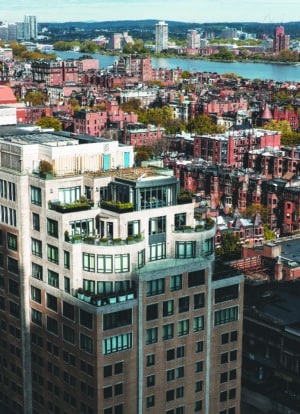
Condominiums at 776 Boylston St. (foreground) can fetch tens of millions of dollars, similar to many homes elsewhere in Boston’s Back Bay neighborhood. iStock photo
Boston’s luxury multifamily market is showing signs of a slowdown, and it is unlikely things like luxe amenities will move the needle in generating more sales.
The number of luxury condominium sales in Boston was down 20 percent for the first three months of this year, according to a market report from The Collaborative Cos. Further, there is a 10 percent decline in the number of listings from the same time as last year.
Don’t expect things to change anytime soon, as high interest rates, economic uncertainty and political instability are all to blame for the slowdown. But the slowdown also prevents more supply from hitting the market – keeping prices stubbornly high in an already expensive housing market.
“Boston is used to selling thousands of units a year, several hundred units a month and at least 200 to 300 luxury units a year,” said Sue Hawkes, managing director at TCC. “You’ve got a supply problem, and then you’ve no one moving because of the interest rates because people are sitting in their 2 [percent] and 3 percent interest rates, and there’s no way they’re going to say, ‘Let’s go get 6 or 7 percent, so they squat in their homes. They’re not moving. So, you don’t even get resales on the market. It’s a real paralysis.”
The rate-lock phenomenon of would-be homeowners sticking with their existing home in lieu of buying a new one with a much higher mortgage rate has a grip on a wide swath of the would-be buyer pool. Ninety-two percent of Boston homeowners are experiencing mortgage rate lock, according to Zillow data from this spring.
The one caveat in the luxury market: All-cash buyers are still out there and active, but there is a major pullback in buyers looking to take on a new mortgage, Hawkes said.
“It’s squeezing the market down to a dribble, and that’s unfortunate,” she added.

Buyers and renters seeking high-end new construction have limited options in Boston as the pace of luxury development slows to a trickle. The Smith No. 99, a South End development, includes dozens of custom art installations and 304 apartments with starting rents just under $3,000. Image courtesy of Kortenhaus Communications
Handful of New Luxury Apartments Arrive
After a decade of thousands of new luxury rentals rising in neighborhoods such as the Seaport District, the pace of high-end apartment completions has slowed to a trickle as well.
At a hilltop site in Brighton, The Davis Cos. is nearing completion of a 252-unit redevelopment of the former Kindred Hospital property, including an 8-story condo building with skyline views and 7-story luxury apartment building, both of which are scheduled to open in the second half of the year.
And at 99 East Dedham St. in South End, developers recently completed the 12-story Smith No. 99 building including 304 luxury apartments, a 2-story roof deck and 20 custom art installations. Current rents start at just under $3,000.
Developers looking to embark on new projects face headwinds. While there are four major luxury multifamily condo projects in the pipeline in Boston, only one – the Ritz-Carlton Residences, Boston, South Station Tower – is under construction.
“If I am looking at the multifamily market, and you have a merchant builder whose goal was to build a building to sell, it is certainly a much more challenging environment than it was a few years ago,” said Jeffrey Myers, Boston research director at Colliers.
TCC’s report notes the average price per square foot and average sale price of a luxury condo building in Boston are down 7 percent and 3 percent, respectively. The report notes the slowdown in construction and shallow pipeline are ultimately putting upward pressure on pricing. Only 556 units are under construction or in various stages of planning. Most of these new construction projects will price out at $2,500 per square foot or higher.
In terms of asset sales, Myers notes the overall Boston multifamily sales environment has slowed down tremendously in recent years – going from roughly $5 billion in early 2022 to about $3 billion at the end of the first quarter of this year.
“That’s a significant drop, and a part of that drop is because the pricing on assets probably needs to slide down a little bit more to reflect the new reality of those higher interest rates,” he added.
Amenities vs. Dollars and Cents
The multifamily building boom of recent years ushered in an era of amenities wars in hopes of wooing new buyers and renters with offerings like club rooms, dog spas and outdoor space. There’s still plenty of amenities to be had: High-end fitness facilities, package facilities for Amazon deliveries and work-from-home-friendly spaces are the norm. Some older properties might even do a light refresh of a lobby or other public space.
But it likely all boils down to dollars and cents (and interest rates) in terms of what might move the needle in generating more transactions, experts say. Still, TCC’s report notes price reductions, concessions and even rent-to-own programs are some of the tactics used on a select basis to move existing condo inventory.
“The biggest hook that people are using is maybe some slight price negotiation, but they’re doing things like paying for condo fees, helping somebody with the first several years’ costs,” Hawkes said.
Luxury condo sales might be down, but creativity can seal the deal in a muted market.
“The argument would be, ‘Okay, fine, you can buy here, and you can get either a high fixed-rate or maybe an [adjustable rate mortgage] and, in a couple of years, you could refinance with something that’s more palatable and easier to carry,” Hawkes added. “‘In the meantime, guess what? We’re going to be paying your condo fees for you, so that helps keeps the cost down so you can afford to be here even at these higher interest rates.’”





